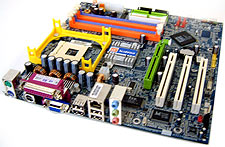Doom 3 is the most advanced OpenGL game to date, it
takes advantage of the latest videocard technology and pushes the processing
power of the CPU to its absolute limits. At its highest setting Ultra quality,
texture sizes pass the 500MB mark which means even tomorrows videocards will
have a hard time running everything. The frame rates in the game itself are
locked at 60 fps so anything above that
point is wasted. Each test is run three times and with the third run being
recorded.
Doom 3 stresses even the fastest of systems, so this
framerate of 12.2 should be no big surprise. But just to underline it, Doom 3
and ATIs Radeon 9200-class integrated video go together about as well as dialup
and this site. ;-)
Maximum Motherboard
Overclock Test
After some discussions for and against removing
overclocking benchmarks from PCstats reviews altogether, we have decided to
change how we do things. From now on, PCstats reviews will simply list the
maximum overclocked speed a motherboard is able to achieve here, rather than for
each benchmark.
Since overclocking can be a very subjective skill, it
just makes more sense to keep our benchmarks focused on the stock performance of
system components. Plus, by listing the maximum overclocked speeds of various
motherboards here, you have a better idea of which manufacturer really does
produce the best goods for enthusiasts! Here's a brief list of Intel
motherboards and their maximum overclocked speeds (Intel Pentium 4 3.0C test
processor) as compared to the Gigabyte GA-8TRS350MT motherboard.
The Gigabyte GA-8TRS350MT is not the fastest motherboard
we've ever tested, and this is clearly visible by the low overclocking result
listed above. Starting at 200 MHz FSB, we slowly increased the GA-8TRS350MT's
clock speed, but without CPU or memory voltages to play with, this little
adventure hit a dead end at 213 MHz.
I suppose it's ATI chipset is just not intended for
enthusiast-class overclocking.... However, if you're into multimedia, that is
where the Gigabyte GA-8TRS350MT really comes into its own.
Conclusions:
While successful in the 3D market, when it comes to
motherboard chipsets ATI is still very much a rookie player. Its original Radeon
9100 IGP Pentium 4 chipset had potential, and in the end was clearly suited to
the value-oriented consumer. The tweaked Radeon 9100 IGP PRO chipset has
approximately 3% more potential, and is clearly best suited for value-oriented,
middle to low-end consumer PC systems. It's Radeon 9200 GPU gives it headroom on
the integrated videocard front, and certainly gives Intel's mainstream and
Taiwanese rivals a run for their money.
ATI appears to have addressed earlier issues with memory
compatibility, and updated its Southbridge solution to include the basics;
Serial ATA/RAID and more USB2.0 ports. Probably the coolest feature ATI has
added though is a set of TV-Outputs as standard equipment! Now if you wan to
assemble a HTPC, one no longer has to buy a new videocard!

Because the Gigabyte GA-8TRS350MT is built on a Micro
ATX form factor, its small size gives users more versatility for situations
where a full ATX PC would be too large. If you're looking for a motherboard for
that HTPC you're thinking about building, the GA-8TRS350MT is perfect. Heck it
even comes with a TV-Out cable which is actually long enough to use!
From our highly subjective tests, the 2D image quality
of the Radeon 9200 GPU was excellent (it has always been one of ATi's strong
suits) while its 3D performance in FPS games was "satisfactory." On the scale of
chipsets, the Radeon 9100IGP weighed in around the level of the i865PE or SiS
655TX. We were unable to track down a price for the Gigabyte GA-8TRS350MT, but I
expect that its intended market will keep things quite competitive. System
integrators tend to look for value-oriented solutions, and the GA-8TRS350MT
certainly fulfills those modest qualifications well.

Find out about this and many other reviews by joining
the Weekly PCstats.com Newsletter today!
Related Articles
Here are
a few other articles that you might enjoy as well...
1. Gigabyte GA-8KNXP Ultra-64 Motherboard Review
